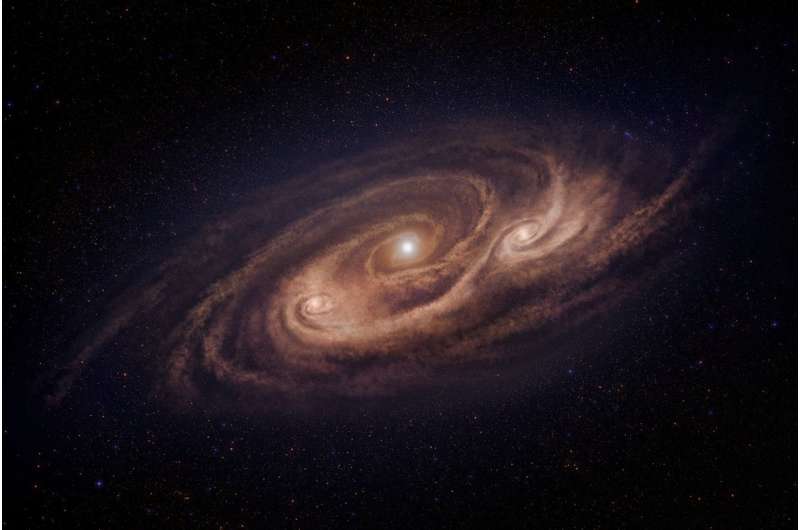In order to successfully complete this assignment you need to participate both individually and in groups during class. Have one of the instructors check your notebook and sign you out before leaving class on Friday January 17.
ICA 03: Galaxy Example#

Image from: https://phys.org/news/2018-08-astronomers-reveal-monster-star-forming-galaxies.html
Agenda for today’s class (70 minutes)#
1. Pre class assignment review#
Discuss this with your group. Briefly summarize what you learned in the pre-class assignment. Why is vim such a powerful tool used by professional programmers?
2. Running GalaxSee on HPCC#
Today we will practice what we have learned on Friday. As a reminder, here are the commands we used:
Step 1: Start an OpenOnDemand interactive desktop session.#
Go to http://OnDemand.hpcc.msu.edu, select “Interactive Apps–>Interactive Desktop”. Set the number of hours to 1 and the number of cores to 1 and the memory to 1GB. Under advanced options set the node type to “Any”. Leave everything else blank and hit “Launch”.
Select “Interactive Apps–>Interactive Desktop” again. This time set the number of hours to 1 and the number of cores to 4 and the memory to 1GB. Under advanced options set the node type to “Any”. Leave everything else blank and hit “Launch”.
Wait for your sessions to start.
NOTE As is the case anytime we use the HPCC, there is no guarantee that these sessions will start during class. This is a shared system and we need to be flexible. You can also do the rest of this assignment on a development node.
Step 2: Open a Terminal app#
Once you have a desktop up and running, open a terminal app from the main menu. Try navigating to “Applications–>System Tools–>Terminal”. Explore this menu a bit to get familiar with some of the programs available inside the interactive desktop.
Step 4: Compile the Galaxsee example code#
Type the following command on the terminal. This will load in the Intel compilers. Some of the examples we are using in class today use the Intel compilers.
module load intel
This example uses a Makefile to help the user know what commands are needed to compile. You an view the Makefile by using the cat (catalog) command:
cat Makefile
We run the commands inside the Makefile using the make program. All you need to do is type make and the program will read the Makefile in the current directory and run it for you.
make
You should see some compiler commands on your screen. This means it is working. Check for errors and debug them.
Step 5: Run the Galaxsee example code#
Assuming everything is working, the build command made a few examples. Lets run the examples from the command line (Note: the computation may go very quickly, add more timesteps and stars to keep the visualization up longer):
././GalaxSee.cxx-mpi
This should run the GalaxSee code inside your virtual desktop window.
To simulate a 1000 stars do:
././GalaxSee.cxx-mpi 1000
To simulate a 1000 stars that are 10 solar masses each do:
././GalaxSee.cxx-mpi 1000 10
To simulate a 1000 stars that are 10 solar masses each for 10000 timesteps do:
././GalaxSee.cxx-mpi 1000 10 10000
To time a simulation of 1000 stars that are 10 solar masses each for 10000 timesteps without vizualization do:
time ./GalaxSee.cxx-mpi 1000 10 10000 0
✅ QUESTION: If you increase the number of stars by a factor of 2 how much does the compute time increase? Do a few increses by 2 to see the trend.
✅ QUESTION: Record the number of stars and runtimes as you increase the number of stars by a factor of 2 above. Create a plot below with star count on the x-axis and runtime in seconds on the y-axis.
# Place your code to generate your plot here
✅ QUESTION: If you aren’t familiar with Big O notation, Google and discuss it with your group. Summarize what your group discussed about your interpretation of Big O notation. Then, using the scaling and plots, estimate the scaling of the simulation using Big O notation.
Write your summary here.
Congratulations, we’re done!#
If you attend class in-person then have one of the instructors check your notebook and sign you out before leaving class. If you are attending asynchronously, turn in your assignment using D2L.
Written by Dr. Dirk Colbry, Michigan State University (Updated by Dr. Nathan Haut in Spring 2025)

This work is licensed under a Creative Commons Attribution-NonCommercial 4.0 International License.
